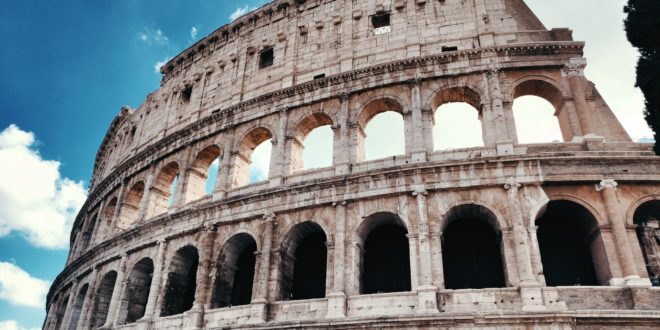Travertine isn’t just popular today in gorgeous homes and world-renowned architectural masterpieces like the Getty Center in Los Angeles.
It was popular in ancient Roman times as well. In fact, it was used aplenty at The Colosseum in Rome. It came from Tivoli and made up the outside wall of The Colosseum, the floors and the primary pillars.
Architects all over the world today take note of travertine tile as they develop and build a host of constructions.
But what is travertine tile, you ask, and why should I use it in my home or building?
To answer your questions, we’ve put together some basics about this stone and our favorite reasons for using it. Keep reading to learn about travertine flooring and the pros of this tile.
Then, talk to your contractor, interior designer or architect and see how it can work in your place for both style and function.
What Is Travertine Tile?
Travertine is made of limestone. It’s a sedimentary formation, calcite, that forms in mineral springs and encircles mineral deposits. Its natural color is primarily white with tints and speckles of red and yellow.
Travertine is most often used to make tiles. The tiles are put together in various earthy tones and pre-set patterns.
Travertine Tile Patterns
The fabulous look of travertine tile in its elegant patterns is one of the main reasons to choose this tile for your home or other structure.
In the U.S., the tile patterns are called French pattern, Ashlar pattern, and Versailles pattern. But really, these are all the same pattern!
In the south, “French” travertine is the name used for the pattern. Take a look at Texas travertine to get an idea.
On the West Coast, the pattern is called Versailles travertine, and on the East Coast, it’s called “Ashlar” travertine.
Travertine Tile Colors
You have a host of earth-tone color schemes to choose from when you go with travertine tiles. Enjoy hues of brown, tan, beige, grey and rust.
The tones come together often with a speckled look, making each tile unlike any other.
Elegant Works of Art
Each travertine floor is unique in the way the pieces and colors come together. This gives your home a prestigious high-end look every time.
The subtle tones also give travertine tiles an understated style that exudes strength at the same time. Travertine flooring gives any room an understated solid feel and lets the rest of the decor be the showpiece instead of the tiles.
Hard Tile
Another benefit of travertine tile is that it is a hard stone and will stand up over time, even with a lot of foot traffic and weathering. This is why travertine tile is often found in rooms that get a lot of use.
Travertine tile flooring is often used in larger public constructions as well — like the Getty Museum — where the foot traffic is enormous. Compare the Getty traffic to that in your home and you can see why travertine is a great choice for your floors.
Over time, you can see a bit of wear, but this just makes the stone look more unique and classic as if it were from Ancient Rome, and the weathered stone is still durable.
Lasts Decades
Since travertine tile is so hard and can withstand foot traffic and actual weather if outside, it is a stone that lasts a long time. Typically, it lasts decades.
And again, when it does wear, it really just makes the stone look that much more attractive.
Easy to Repair
When there is an issue with a tile — like if it breaks or cracks due to some unusual pressure, it’s easy to repair.
You don’t need to take out your entire floor; you can just replace that one tile. A flooring professional will be able to do it in a snap.
When you install your travertine tile flooring, be sure to order extra tiles. That way, when you do need to have the rare tile replacement, you can just grab one of your extras knowing it’s the right tone to match the rest of your floor.
It may not be weathered or worn from walking exactly the same as the rest of the floor but it will be mighty close and the color tone will be the same.
Sealer Can Be Applied for Maintenance
Travertine tile has tiny pores as do other limestone tiles and other stone tiles used for flooring. A simple trick is to apply a sealer to your travertine tiles during installation after you set them.
The sealer that’s used is a barrier sealer that keeps liquids from staining your tiles.
Great for Strong Structures
Travertine is a very heavy stone. This adds to its strength and durability.
Its weight, however, should be taken into consideration. It’s great for durable structures and as ground flooring.
Even when used as ground flooring, however, the structure beneath the tiles should be strong enough to hold the travertine without bending.
For this reason, it’s very important to consult with your contractor, interior designer and/or architect when choosing travertine tile. Be sure to use a professional installer as well. The installer will be able to ensure that the structure beneath is ideal to hold your tile.
Retains the Temperature
Travertine tile is great for taking in the temperature around it. This is better when the temperature is warm rather than cold. However, in extremely hot climates, it’s nice that the travertine holds in the coolness of the air inside and keeps the temperature a bit lower.
In colder climates, going with stylish throw rugs can warm up the room and stone and also add a nice splash of decor.
Travertine Tile for You
Now that we’ve answered the “What is travertine tile?” question and extolled its virtues as a gorgeous, durable stone, you’re ready to look at travertine tile for your abode or architectural project.
Talk to your contractor, designer or architect and contact a trustworthy travertine supplier. You’ll be on your way to a gorgeous floor or walls.
While you’re at it, keep perusing our blog for other useful posts for living an eco-friendly, sustainable, prosperous, and healthy life — so you can fully enjoy that tile when it’s in!




